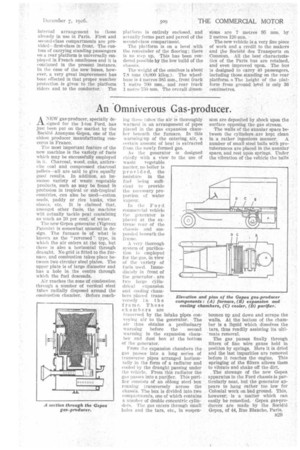An . 01 - nniverous Gas-producer.
Page 55

If you've noticed an error in this article please click here to report it so we can fix it.
A'Ew gas-producer, specially designed for the 1-ton Ford, has just been put on the market by the Soei6td Anonyme Gepea, one of the oldest producer manufacturing concerns in France.
The most important feature of the new machine is the variety of fuels which may be successfully employed in it. Charcoal, wood, coke, anthracite coal and compressed charcoal pellets---all are said to give equally good results, In addition, an lmmouse variety of waste vegetable products, such as may be found in Profusion in tropical or sub-tropical countries, can also be used—cotton. seeds, paddy or rice husks, vine shoots, etc. It is claimed that, amongst other fuels, the machine will actually tackle peat containing as much as 20 per cent. of water.
The new Gepea generator (Vigreux Patents) is somewhat unusual in design. The furnace is of what is known as the " reversed " type, in \Illicit the air enters at the top, but there is aLso a horizontal through draught No grid is fitted to the furnace, and combustion takes place between two circular steel plates. The upper plate is of large diameter and has a hole in the centre through which the fuel descends.
Air reaches the zone of combustion through a number of vertical steel tubes radially disposed around the combustion chamber. • Before reach ing these tubes the airis thoroughly warmed in an arrangement of pipes placed in the gas expansion chamber beneath the furnace. In this worming-up of the entering, air, a eerie in amount of heat is extracted from the newly formed gas.
As the generator is designed chiefly with a view to the use of waste vegetable tter, no boiler is provided, the moisture in the fuel being sufficient to provide the necessary proportion of water vapour.
In the Ford commercial vehicle the generator is placed at the extreme rear of the el m ssis and suss pe.teled beneath the frame.
A very thorough system of purification is employed for the gas, in view of the variety of fuels used. Immetlintely ;r1 front of the generator. are two large Olindrieal expansion and cooling chanthors placed transversely in the frame. These chambers are traversed by the intake pipes conveying air to the generator. The air TIFLIS obtains a preliminary WU tilling before the second warming in the expansion chamber and dust box at the bottom of the generator.
From the expansion chambers the gas passes into a long series of transverse pipes arranged horizontally in the form of a radiator and cooled by the draught passing under the vehicle. From this radiator the gas passes into a purifier. This purifier consists of an oblong steel box running transversely across the chassis. The box is divided into two compartments, one of which contains a number of double concentric cylinders. The gas enters through small holes and the tars, etc., in suspen
sion are deposited by shock upon the surface opposing the gas stream.
The walls of the annular space between the cylinders are kept clean in a rather ingenious manner. A number of small steel balks with protutierance.s are placed in the annular space, and rest upon springs. Under the vibration of the vehicle the balls
bounce up and down and scrape the walls. At the bottom of the chamber is a liquid which dissolves the tars, thus readily assisting its ultimate removal.
The gas passes finally through filters of fine wire gauze held in position by springs. Here it is dried and the last impurities are removed before it reaches the engine. This springing of the filters allows them to vibrate and shake off the dirt.
The stowage of the new Gepea apparatus in the Ford chassis is particularly neat. but the generator appears to hang rather too low for Colonial work on had ground. This, however, is a matter which can easily be remedied. Gepea gas-producers are made by the Societe' Gepea, of 44, Rue Blanche, Paris.




















































































































